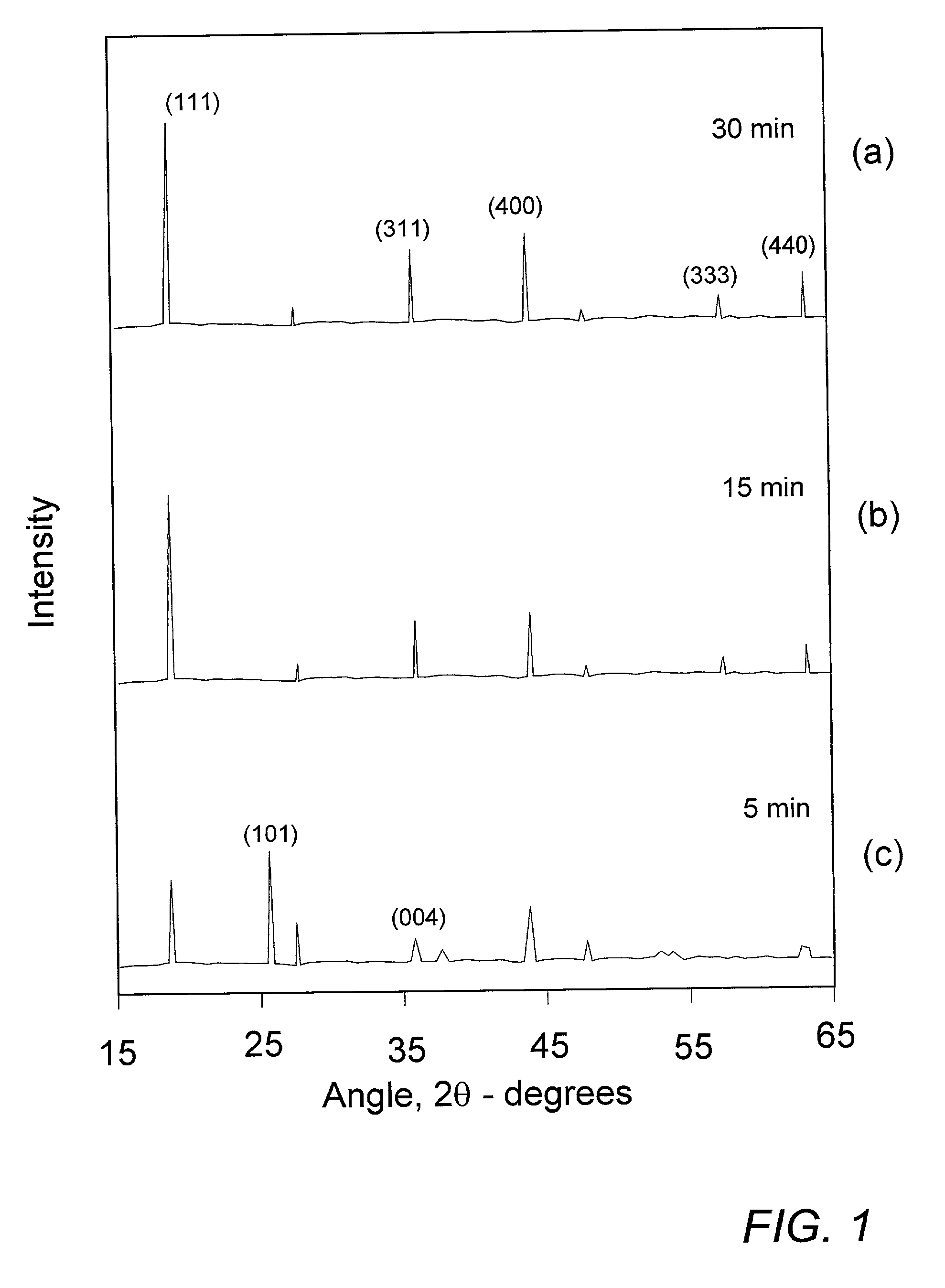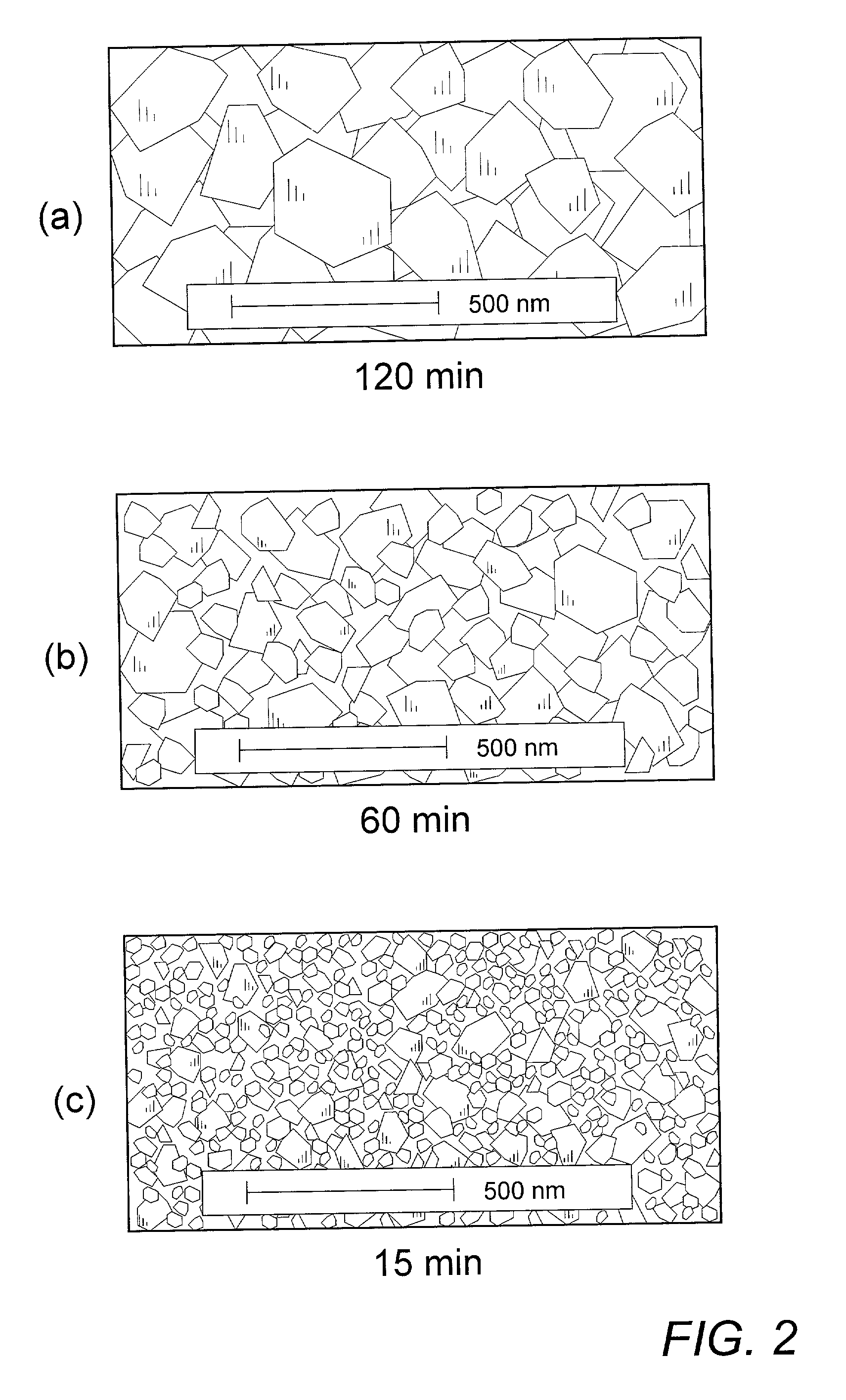Nanostructure lithium titanate electrode for high cycle rate rechargeable electrochemical cell
a lithium titanate electrode, high cycle rate technology, applied in the direction of lithium compounds, alkali titanates, cell components, etc., can solve the problems of significant loss detriment to the ultimate operation of rechargeable cell devices, and detriment to the effect of electrochemical cell capacity loss
- Summary
- Abstract
- Description
- Claims
- Application Information
AI Technical Summary
Benefits of technology
Problems solved by technology
Method used
Image
Examples
example i
[0026]The determination of minimum annealing time for sufficient reaction of mixed precursor compounds was effected in the following manner. 40.0 g of commercial nanostructure TiO2 (30–50 nm) was dry-milled with 14.8 g of Li2CO3 to obtain an homogeneous master batch of precursor mixture. Sample portions of about 2 g of the master mix were successively utilized by distributing the powder as a layer of about 10 mm thickness in the bottom of an alumina crucible and inserting the crucible into an oven preheated to about 750–800° C. Each subsequent sample was allowed to remain in the oven for a decreasing predetermined time before being removed and allowed to immediately cool to room temperature, thereby essentially quenching the sample and preventing further reaction. The resulting Li4Ti5O12 reaction product was then examined by standard CuKαx-ray diffraction (XRD) to ascertain whether the applied annealing time were sufficient to ensure complete reaction of the mixed precursors.
[0027]S...
example ii
[0030]As seen in FIG. 3, a battery test cell structure 30 comprises a positive electrode member 33, a negative electrode member 37, and an interposed separator member 35 containing cell electrolyte. Current collector members 31, 39 associated with the respective positive and negative electrode members provide points of electrical circuit contact for the cell.
[0031]Typically, positive electrode 33 comprises a vinylidene copolymer matrix membrane in which is dispersed the Li4Ti5O12 test material, while negative counter-electrode 37 comprises a similar copolymer matrix dispersion of an active material compound, or simply an active metal foil, capable of reversibly plating, alloying, intercalating, or otherwise providing a source of lithium ions. Separator 35 may likewise be a polymeric membrane, as described in the referenced specification, or it may comprise a widely used microporous membrane or simply a glass fiber mat, any of which is capable of retaining the non-aqueous electrolyte...
example iii
[0035]Similar series of test cells were cycled at varying increased rates of 1C, 5C, and 10C to determine the effect of Li4Ti5O12 particle size on the ability of a cell to exhibit stable high capacity levels while cycling at such higher rates. The resulting data were plotted as indication of the degree of initial capacity, as determined in Example II, which each active material sample of increasingly long anneal time, and thus larger particle size, was capable of maintaining as input current density increased, and thus intercalation time decreased. The plots of such data shown in FIG. 5 indicate the superior capacity retention of the preferred, smaller particle Li4Ti5O12 materials obtained from annealing times in the range of 15–30 min. The unsatisfactory performance of materials prepared by annealing in excess of about 8 h in accordance with the above-noted practices of the prior art are particularly apparent.
PUM
| Property | Measurement | Unit |
|---|---|---|
| particle size | aaaaa | aaaaa |
| particle sizes | aaaaa | aaaaa |
| temperature | aaaaa | aaaaa |
Abstract
Description
Claims
Application Information
 Login to View More
Login to View More - R&D
- Intellectual Property
- Life Sciences
- Materials
- Tech Scout
- Unparalleled Data Quality
- Higher Quality Content
- 60% Fewer Hallucinations
Browse by: Latest US Patents, China's latest patents, Technical Efficacy Thesaurus, Application Domain, Technology Topic, Popular Technical Reports.
© 2025 PatSnap. All rights reserved.Legal|Privacy policy|Modern Slavery Act Transparency Statement|Sitemap|About US| Contact US: help@patsnap.com



